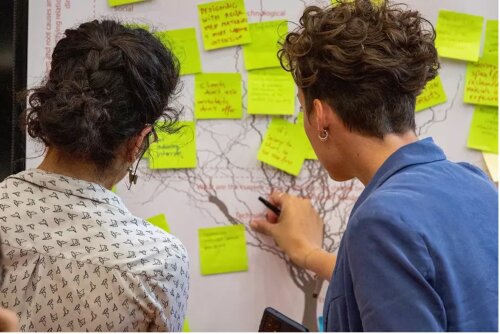Beyond borders towards a circular built environment
Making the Circular Built Environment a Reality: A Call for Collaboration – public debate
December 12th, 19 - 21h
Hof Van Liere en F. De Tassiszaal
Prinsstraat 13, Antwerpen

The Henry Van de Velde Research Group (HvdV) at the University of Antwerp and the Circular Built Environment Hub (CBE Hub) at Delft University of Technology are joining forces. Both groups have been working on circularity topics for more than a decade, systematically transcending boundaries and disciplines. Their goal is to create a regenerative circular built environment. Today, they see similar insights emerging in both countries. On December 12, they will debate this with the general public.
What to expect:
- discuss and exchange ideas on how to work with the associated complexities around value chains and spatial impact
- breaking down the issues into manageable opportunities, steps and roadmaps and looking across (national) borders to identify solution directions and concrete actions
- learning from each other's perspectives, in whatever role: manufacturer, constructor, researcher, policymaker, designer, developer, owner or user of the built environment
Background to the event
The CBE Hub recently released a statement concerning barriers in current Dutch governance – in broad terms – to systemically address transitional mechanisms. Three barriers were specified for collaborative scrutiny:
Spatial consequences and impact of circularity are a blind spot.
Implementation and upscaling of circular initiatives is lacking.
Integration of and synergies between value chains remain underexplored.
From a Flanders perspective, those barriers are recognized. Thus far, the state of affairs for circularity has been monitored along the lines of macro-economic statistics on material input/output and consumption. However, it is increasingly acknowledged that a fair and effective assessment requires much more than that. A recent report concerning the underlying processes on meso and micro levels stated amongst others that:
Built areas are still expanding at the cost of natural land and wildlife habitats.
More virgin raw materials are excavated for the building sector than secondary raw materials are delivered from the recycling routes.
Down-cycling, thus the loss of material quality in the recycling route, is common practice.
The current focus on material flows and sustainable strategies is too limited, and not attuned to fundamental shifts in economic thinking at the heart of the CE concept.
Current indicators regarding the CE of buildings and housing run short and aspects are measured poorly, while data on building material compositions, end-of-life processes, and impacts of buildings and housing on society are missing vastly.
The evaluations of Flanders and The Netherlands show many overlaps and parallels, the overarching conclusion being that current efforts do not suffice and collaboration between all society partners must be strengthened if 2030 and 2050 goals are to be reached. To overcome the obstacles, research and education on the field of the circular built environment need to continue to focus on the systemic nature of this transition and the inevitability of the fact that institutions, organizations and individuals alike, all need to work together. This collaboration is crucial for envisioning circular futures, and co-creating the values we need to safeguard or further achieve. Much about the circular economy might be uncertain, but the need for technical, organizational, and social innovation is a well-accepted fact.